2005 SUBARU FORESTER coolant level
[x] Cancel search: coolant levelPage 266 of 477

7-9
Starting and operating
– CONTINUED –
Preparing to drive
You should perform the following checks and adjust-
ments every day before you start driving.
1. Check that all windows, mirrors, and lights are
clean and unobstructed.
2. Check the appearance and condition of the tires.
Also check tires for proper inflation.
3. Look under the vehicle for any sign of leaks.
4. Check that the hood and rear gate are fully closed.
5. Check the adjustment of the seat.
6. Check the adjustment of the inside and outside mir-
rors.
7. Fasten your seatbelt. Check that your passengers
have fastened their seatbelts.
8. Check the operation of the warning and indicator
lights when the ignition switch is turned to the “ON” po-sition.
9. Check the gauges, indicator and warning lights af-
ter starting the engine.
NOTE
Engine oil, engine coolant, brake fluid, washer flu-
id and other fluid levels should be checked daily,
weekly or at fuel stops.
Starting the engine
Do not operate the starter motor continuously
for more than ten seconds. If the engine fails to
start after operating the starter for five to ten
seconds, wait for ten seconds or more before
trying again.
�„ Manual transmission vehicle
1. Apply the parking brake.
2. Turn off unnecessary lights and accessories.
3. Press the clutch pedal to the floor and shift the shift
lever into neutral. Hold the clutch pedal to the floor
while starting the engine.
The starter motor will only operate when the clutch
pedal is pressed fully to the floor.
4. Turn the ignition switch to the “ON” position and
check the operation of the warning and indicator lights.
Refer to the “Warning and indicator lights” section(chapter 3).
5. Turn the ignition switch to the “START” position
without depressing the accelerator pedal. Release
the key immediately after the engine has started.
Page 349 of 477
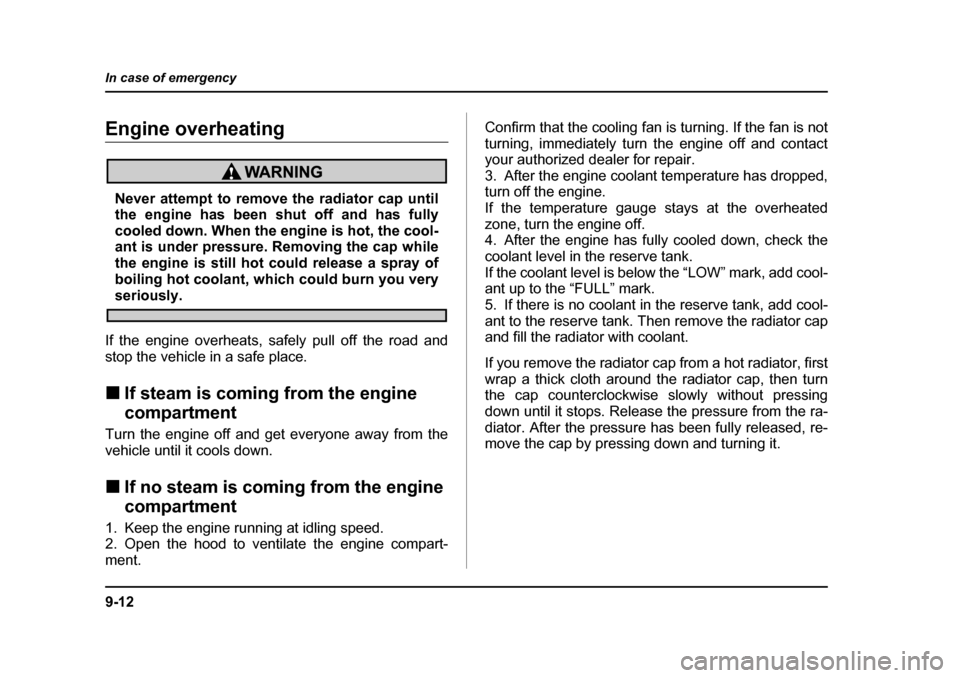
9-12
In case of emergency
Engine overheating
Never attempt to remove the radiator cap until
the engine has been shut off and has fully
cooled down. When the engine is hot, the cool-
ant is under pressure. Removing the cap while
the engine is still hot could release a spray of
boiling hot coolant, which could burn you very
seriously.
If the engine overheats, safely pull off the road and
stop the vehicle in a safe place. �„ If steam is coming from the engine
compartment
Turn the engine off and get everyone away from the
vehicle until it cools down. �„ If no steam is coming from the engine
compartment
1. Keep the engine running at idling speed.
2. Open the hood to ventilate the engine compart- ment. Confirm that the cooling fan is turning. If the fan is not
turning, immediately turn the engine off and contact
your authorized dealer for repair.
3. After the engine coolant temperature has dropped,
turn off the engine.
If the temperature gauge stays at the overheated
zone, turn the engine off.
4. After the engine has fully cooled down, check the
coolant level in the reserve tank.
If the coolant level is below the “LOW” mark, add cool-
ant up to the “FULL” mark.
5. If there is no coolant in the reserve tank, add cool-
ant to the reserve tank. Then remove the radiator cap
and fill the radiator with coolant.
If you remove the radiator cap from a hot radiator, first
wrap a thick cloth around the radiator cap, then turn
the cap counterclockwise slowly without pressing
down until it stops. Release the pressure from the ra-
diator. After the pressure has been fully released, re-
move the cap by pressing down and turning it.
Page 366 of 477

11 - 1
11
Maintenance and service
Maintenance schedule ................................. 11-3
Maintenance precautions ............................ 11-3 Before checking or servicing in the engine compartment .................................................. 11-4
When you do checking or servicing in the engine compartment while the engine is
running ............................................................ 11-5
Engine hood .................................................. 11-5
Engine compartment overview ................... 11-8 Non-turbo models ............................................. 11-8
Turbo models .................................................... 11-9
Engine oil ...................................................... 11-10 Checking the oil level ....................................... 11-10
Changing the oil and oil filter .......................... 11-11
Recommended grade and viscosity ................ 11-13
Recommended grade and viscosity under severe driving conditions .............................. 11-15
Synthetic oil ....................................................... 11-15
Cooling system ............................................. 11-16 Cooling fan, hose and connections ................ 11-16
Engine coolant .................................................. 11-17
Air cleaner element ...................................... 11-21 Replacing the air cleaner element ................... 11-21
Spark plugs ................................................... 11-25 Recommended spark plugs ............................. 11-26
Drive belts ..................................................... 11-26
Manual transmission oil ............................... 11-27 Checking the oil level ....................................... 11-27
Recommended grade and viscosity ................ 11-28 Automatic transmission fluid ...................... 11-29
Checking the fluid level .................................... 11-29
Recommended fluid ......................................... 11-31
Front differential gear oil (AT vehicles) ...... 11-31 Checking the oil level ....................................... 11-31
Recommended grade and viscosity ............... 11-32
Rear differential gear oil ............................... 11-33 Checking the gear oil level .............................. 11-33
Recommended grade and viscosity ............... 11-34
Power steering fluid ...................................... 11-34 Checking the fluid level .................................... 11-34
Recommended fluid ......................................... 11-35
Brake fluid ..................................................... 11-36 Checking the fluid level .................................... 11-36
Recommended brake fluid ............................... 11-36
Clutch fluid (MT vehicles) ............................ 11-37 Checking the fluid level .................................... 11-37
Recommended clutch fluid .............................. 11-37
Brake booster ................................................ 11-38
Brake pedal .................................................... 11-38 Checking the brake pedal free play ................ 11-38
Checking the brake pedal reserve distance ... 11-39
Clutch pedal (MT vehicles) ........................... 11-39 Checking the clutch function .......................... 11-39
Checking the clutch pedal free play ............... 11-40
Hill holder (MT vehicles – if equipped) ....... 11-40
Replacement of brake pad and lining ......... 11-41 Breaking-in of new brake pads and linings .... 11-41
Parking brake stroke .................................... 11-42
Page 373 of 477
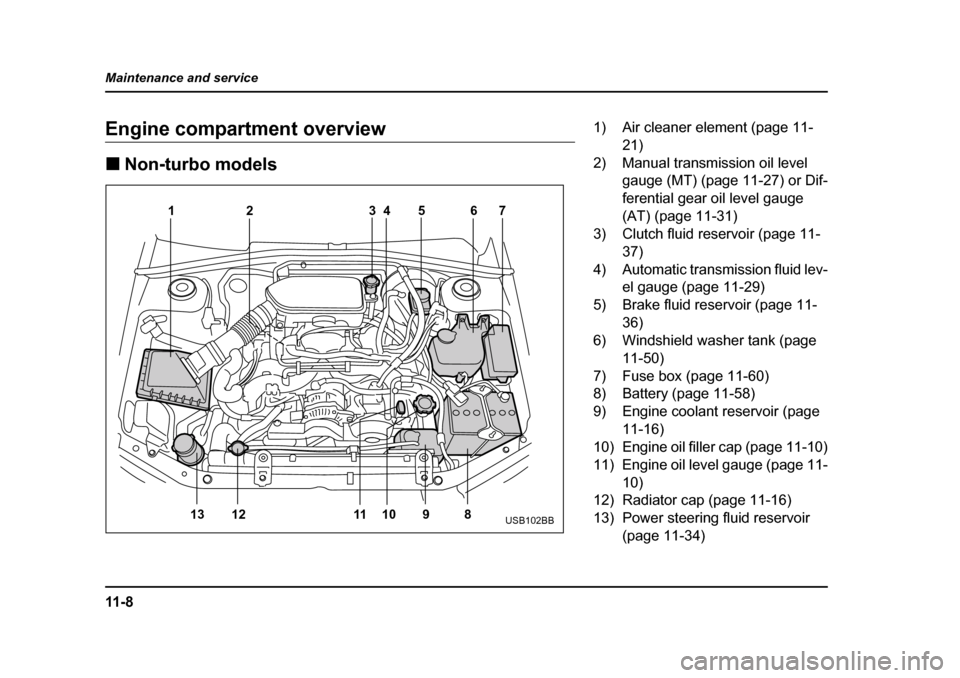
11 - 8
Maintenance and service
Engine compartment overview �„
Non-turbo models
13 12 11 10 9 8 23
5
46
17USB102BB
1) Air cleaner element (page 11-
21)
2) Manual transmission oil level gauge (MT) (page 11-27) or Dif-
ferential gear oil level gauge
(AT) (page 11-31)
3) Clutch fluid reservoir (page 11-
37)
4) Automatic transmission fluid lev- el gauge (page 11-29)
5) Brake fluid reservoir (page 11- 36)
6) Windshield washer tank (page
11-50)
7) Fuse box (page 11-60)
8) Battery (page 11-58)
9) Engine coolant reservoir (page 11-16)
10) Engine oil filler cap (page 11-10)
11) Engine oil level gauge (page 11- 10)
12) Radiator cap (page 11-16)
13) Power steering fluid reservoir (page 11-34)
Page 374 of 477
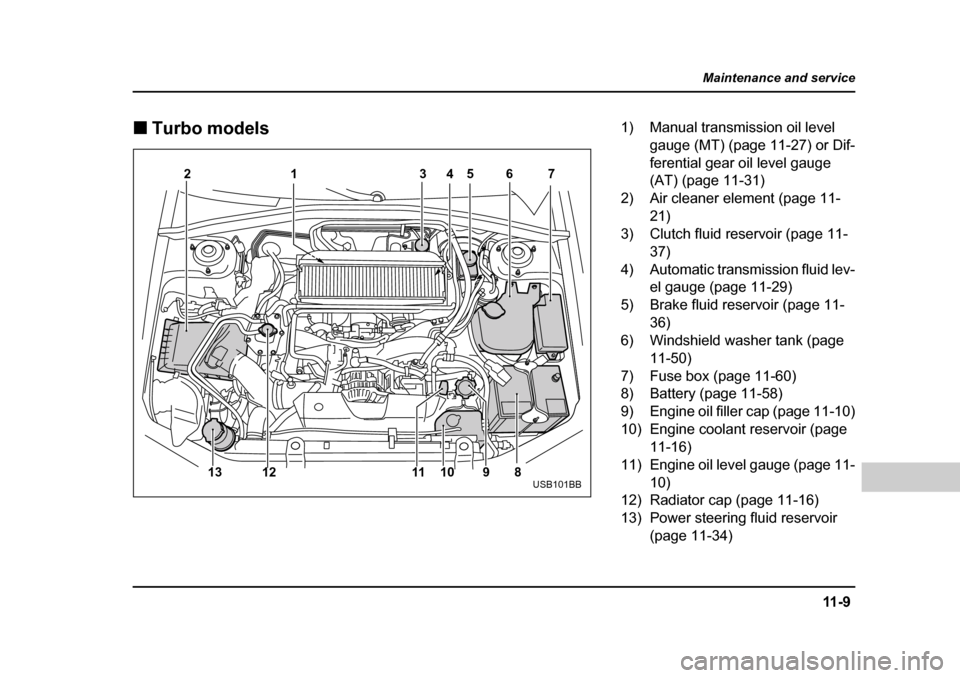
11 - 9
Maintenance and service
– CONTINUED –
�„Turbo models
1
23 5
467
8
9
10
11
12
13
USB101BB
1) Manual transmission oil level
gauge (MT) (page 11-27) or Dif-
ferential gear oil level gauge
(AT) (page 11-31)
2) Air cleaner element (page 11- 21)
3) Clutch fluid reservoir (page 11-
37)
4) Automatic transmission fluid lev- el gauge (page 11-29)
5) Brake fluid reservoir (page 11- 36)
6) Windshield washer tank (page
11-50)
7) Fuse box (page 11-60)
8) Battery (page 11-58)
9) Engine oil filler cap (page 11-10)
10) Engine coolant reservoir (page 11-16)
11) Engine oil level gauge (page 11- 10)
12) Radiator cap (page 11-16)
13) Power steering fluid reservoir (page 11-34)
Page 382 of 477
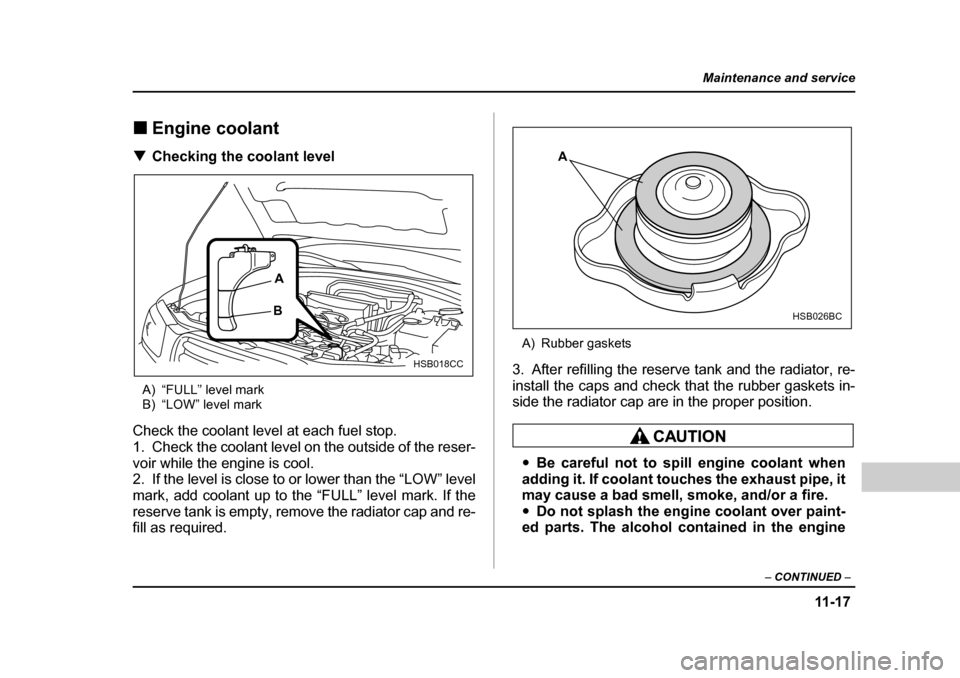
11 -1 7
Maintenance and service
– CONTINUED –
�„Engine coolant
�T Checking the coolant level
A) “FULL” level mark
B) “LOW” level mark
Check the coolant level at each fuel stop.
1. Check the coolant level on the outside of the reser-
voir while the engine is cool.
2. If the level is close to or lower than the “LOW” level
mark, add coolant up to the “FULL” level mark. If the
reserve tank is empty, remove the radiator cap and re-
fill as required. A) Rubber gaskets
3. After refilling the reserve tank and the radiator, re-
install the caps and check that the rubber gaskets in-
side the radiator cap are in the proper position.
�y Be careful not to spill engine coolant when
adding it. If coolant touches the exhaust pipe, it
may cause a bad smell, smoke, and/or a fire. �y Do not splash the engine coolant over paint-
ed parts. The alcohol contained in the engine
HSB018CC
A
B
A
HSB026BC
Page 384 of 477
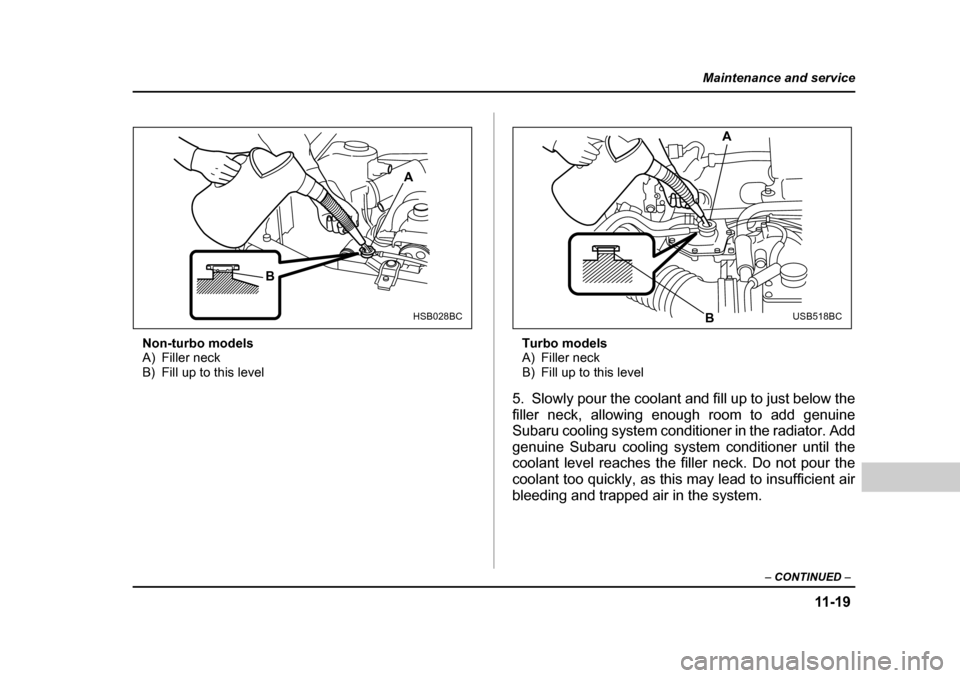
11 -1 9
Maintenance and service
– CONTINUED –
Non-turbo models
A) Filler neck
B) Fill up to this level Turbo models
A) Filler neck
B) Fill up to this level
5. Slowly pour the coolant and fill up to just below the
filler neck, allowing enough room to add genuine
Subaru cooling system conditioner in the radiator. Add
genuine Subaru cooling system conditioner until the
coolant level reaches the filler neck. Do not pour the
coolant too quickly, as this may lead to insufficient air
bleeding and trapped air in the system.
A
B
HSB028BC
A
B
USB518BC
Page 385 of 477
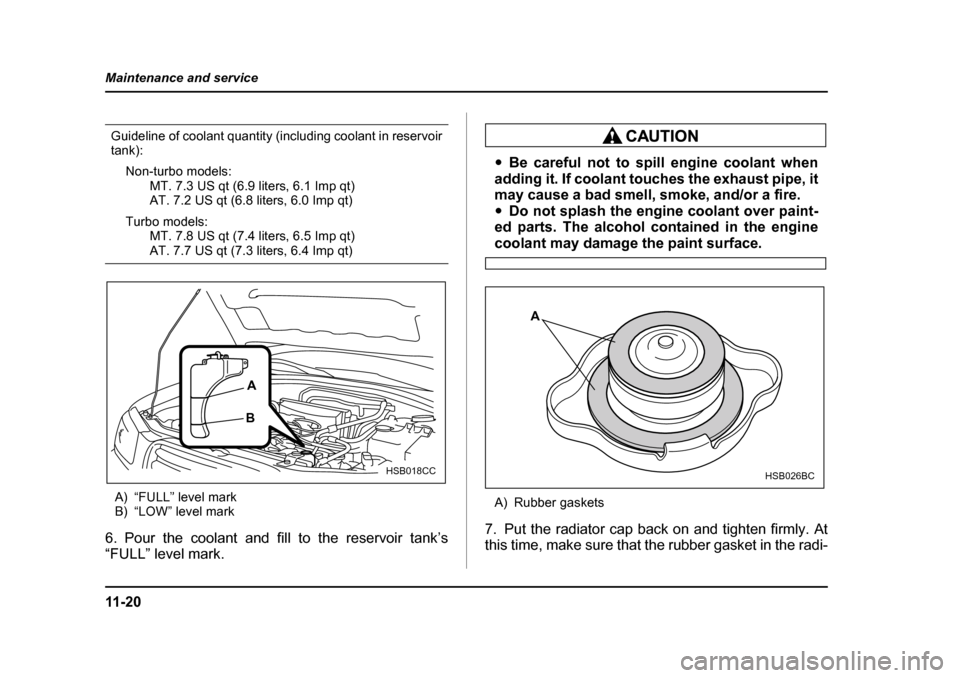
11 - 2 0
Maintenance and service
Guideline of coolant quantity (including coolant in reservoir tank):
Non-turbo models: MT. 7.3 US qt (6.9 liters, 6.1 Imp qt)
AT. 7.2 US qt (6.8 liters, 6.0 Imp qt)
Turbo models: MT. 7.8 US qt (7.4 liters, 6.5 Imp qt)
AT. 7.7 US qt (7.3 liters, 6.4 Imp qt)
A) “FULL” level mark
B) “LOW” level mark
6. Pour the coolant and fill to the reservoir tank’s
“FULL” level mark.
�y Be careful not to spill engine coolant when
adding it. If coolant touches the exhaust pipe, it
may cause a bad smell, smoke, and/or a fire. �y Do not splash the engine coolant over paint-
ed parts. The alcohol contained in the engine
coolant may damage the paint surface.
A) Rubber gaskets
7. Put the radiator cap back on and tighten firmly. At
this time, make sure that the rubber gasket in the radi-
HSB018CC
A
B
A
HSB026BC